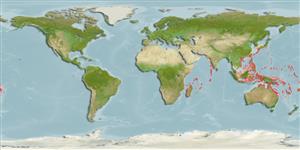>
Blenniiformes (Blennies) >
Tripterygiidae (Triplefin blennies) > Tripterygiinae
Etymology: Helcogramma: Greek, helkos, -eos, -ous = ulcer, sore + Greek, gramma = letter, mark (Ref. 45335).
Environment: milieu / climate zone / depth range / distribution range
Ecologia
marino associati a barriera corallina; distribuzione batimetrica 0 - 10 m (Ref. 6211). Tropical
Indo-West Pacific: South Africa and Arabia to Taiwan and New Guinea.
Size / Peso / Age
Maturity: Lm ? range ? - ? cm
Max length : 3.8 cm SL maschio/sesso non determinato; (Ref. 75031)
Short description
Chiavi di identificazione | Morfologia | Morfometria
Spine dorsali (totale) : 16 - 18; Raggi dorsali molli (totale) : 10 - 12; Spine anali: 1; Raggi anali molli: 19 - 21; Vertebre: 36 - 38. Diagnosis: Dorsal fin III + XIV+ 11, 1st fin 4/5 height of 2nd fin, 1 free pterygiophore between 2nd and 3rd fin; anal fin I + 21; pectoral rays 17 (1+9+7); pelvic fin I, 2, spine short and hidden, segmented rays simple, partially united by membrane. Vertebrae 10 + 27. LL total lateral scales 39-40; tubed 22-30 scales, ends below anterior half of 3rd dorsal fin; nape, 1st and 2nd dorsal fin and anal-fin base scaleless, caudal fin base with 1 row of scales. Mandibular pores 5-8+1-2+5-8. Orbital cirrus simple. Head length 3.4 in SL; eye 2.9, maxilla 2.1 in HL. Male head with blue stripe below eye from mouth to pectoral-fin base and masked with black on ventral half; body pinkish orange with scattered dusky rosettes denser ventrally; larger ones with 5-6 light grey blotches and dusky triangular marks; median fins generally uniformly dark to black. Female paler version of male but not masked (Ref. 75031).
Adults live on rock surfaces and under ledges; common at depths less than 10 m (Ref. 6211). Eggs are hemispherical and covered with numerous sticky threads that anchor them in the algae on the nesting sites (Ref. 240). Larvae are planktonic which occur primarily in shallow, nearshore waters (Ref. 94114).
Life cycle and mating behavior
Maturities | Riproduzione | Spawnings | Egg(s) | Fecundities | Larve
Hansen, P.E.H., 1986. Revision of the tripterygiid fish genus Helcogramma, including descriptions of four new species. Bull. Mar. Sci. 38(2):313-354. (Ref. 6211)
IUCN Red List Status (Ref. 130435)
Threat to humans
Harmless
Human uses
Strumenti
Special reports
Download XML
Fonti Internet
Estimates based on models
Preferred temperature (Ref.
123201): 24.7 - 29.3, mean 28 °C (based on 1759 cells).
Phylogenetic diversity index (Ref.
82804): PD
50 = 0.5000 [Uniqueness, from 0.5 = low to 2.0 = high].
Bayesian length-weight: a=0.00562 (0.00258 - 0.01228), b=3.08 (2.89 - 3.27), in cm total length, based on LWR estimates for this (Sub)family-body shape (Ref.
93245).
Trophic level (Ref.
69278): 3.1 ±0.3 se; based on size and trophs of closest relatives
Resilienza (Ref.
120179): Alto, tempo minimo di raddoppiamento della popolazione meno di 15 mesi (Preliminary K or Fecundity.).
Fishing Vulnerability (Ref.
59153): Low vulnerability (10 of 100).
Nutrients (Ref.
124155): Calcium = 462 [187, 1,675] mg/100g; Iron = 2.48 [0.96, 5.42] mg/100g; Protein = 18 [16, 20] %; Omega3 = 0.0928 [, ] g/100g; Selenium = 48.8 [10.8, 192.0] μg/100g; VitaminA = 73.9 [13.0, 457.5] μg/100g; Zinc = 4.84 [2.25, 8.83] mg/100g (wet weight);
